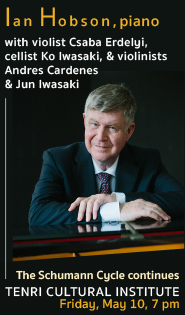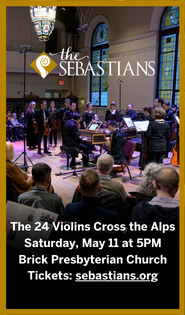A convivial evening of Czech music centered on the prolific Juraj Filas
The Year of Czech Music, New York edition, got under way Friday night with a convivial evening of chamber music at the Consulate General of the Czech Republic on East 73rd Street.
The featured composer was the prolific Juraj Filas, whose modern yet approachable music graced many a film and concert stage until his death in 2021, at age 66.
A distinguished trio of Filas’s friends—longtime New York Philharmonic principal trombonist Joe Alessi, violinist Ivan Žematý and piccolo trumpeter Otto Sauter—each played solo pieces composed for them. Music by Dvořák, Josef Suk, and Franz Querfurth rounded out the hourlong program.
Martha Locker presided throughout at the Czech-made Petrof piano, displaying formidable technical chops and coaxing a fine variety of voicings from the medium-sized grand.
Since Mozart’s time and before, Czech musicians have enjoyed international prominence and influence out of proportion to their nation’s population. The Year of Czech Music, now being observed by Carnegie Hall and other presenters worldwide, got its start during celebrations of the Smetana centennial in 1924, when someone noticed that years ending in 4 also were significant dates for Dvořák, Janáček, Suk, and other Czech notables. The commemorative year has been declared in every “4” year since.
Jan Lipavský, Minister of Foreign Affairs of the Czech Republic, joined other dignitaries with brief words of welcome Friday night. Then pianist Locker put a gentle habanera sway under Alessi’s tender phrasing and subtle lip vibrato in Suk’s “Piseň Lásky” (Love Song).
Chatting with the evening’s emcee, the filmmaker Anna Eva Kotyza, Alessi recalled meeting composer Filas at a brass festival in Switzerland and forming a friendship that led to Filas’s 1996 sonata for trombone and piano titled At the End of the Century. On Friday the single-movement piece, with its intricate trombone-piano dialogue, misterioso muted passages and stormy coda, eloquently evoked the Y2K anxieties and international tensions as the year 2000 approached.
Violinist Ženatý followed with a 2003 Filas work dedicated to him, Les Adieux, Romance for violin and piano. The players built the songful adagio in graceful, then more urgent lines to a throbbing fortissimo in clear triadic harmonies, then descended through more questioning phrases to close on pianissimo chords and one last pizzicato note.

In the exuberant finale from Dvořák’s Sonatina for Violin and Piano, Op. 100, Ženatý and Locker delighted listeners with catchy rhythms, a garland of Czech tunes from spirited to soulful, and a nostalgic look back before the fiery presto coda. (Members of the largely Czech audience could be seen dabbing their eyes afterward.)
The piccolo trumpet, known for its brilliance and agility in the music of J.S. Bach and his contemporaries, is less associated with lyrical playing, but Otto Sauter made an eloquent case for that in two adagios by Filas Friday night. First, however, he went Baroque with the Concerto in E-flat major by Franz Querfurth, a composer whose exact dates, and even other compositions, are apparently lost to history.
The skillful Sauter made a case for Querfurth too, both in a 2007 recording and at Friday’s concert. Substituting for a string orchestra, pianist Locker was lively and stylish for the period, hustling to keep up with the little trumpet’s blistering triplets. In between smiling with satisfaction after gnarly passages (and perhaps also giving his lips a stretch), Sauter played with limpid tone and graceful ornaments.
The concerto’s Adagio, a simple song in short phrases, stepped along at a stately pace. Locker opened the Presto finale in a broad, swinging three, but Sauter bumped it up to a true presto, and then both players successfully navigated the movement’s tricky swerves and fast repeated notes.
In conversation onstage, Sauter claimed the record for works commissioned from Filas by one artist, at 7. Furthermore, he indicated that the Adagio in C major for piccolo trumpet and piano was receiving its world premiere that night. The work impressed with its noble, Handelian melody in the outer sections and turbulent minor-key interlude. Exerting exceptional breath control at the high pressure required to make the small trumpet sound, Sauter managed to rival the expressive capacities of his instrument’s larger, lower-pitched siblings.
In Sauter’s tender rendition, the wistful melody of Filas’s 2005 Adagio in C minor put one in mind of Michel Legrand’s lush movie themes. Pianist Locker took it up and outdid even Sauter for romantic rubato, before swelling toward a forte trumpet entrance and the piece’s dramatic coda.
After an enthusiastic curtain call for all the artists (except Alessi, who had taken his leave), the audience adjourned to an adjoining room for refreshments and animated conversation in at least two languages.








